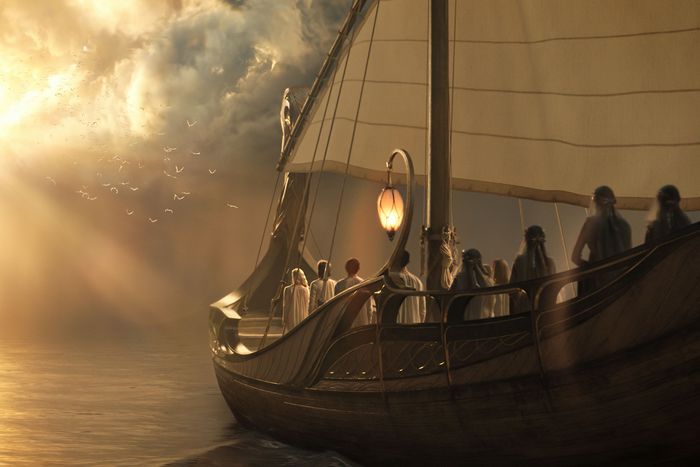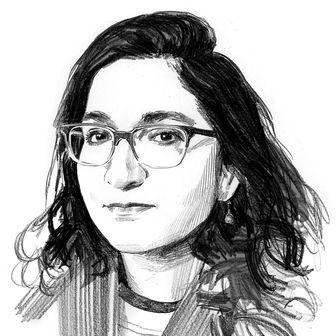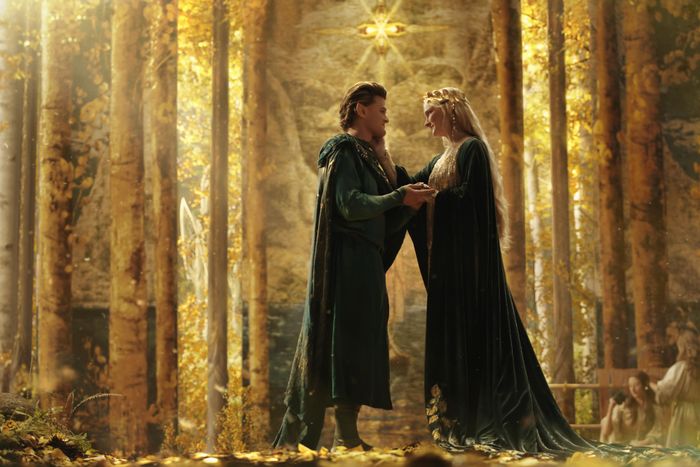
Google “Game of Thrones too dark” and you’ll get more than 38 million hits, including cinematographer Fabian Wagner blaming the notoriously gloomy lighting and impenetrable action of “The Long Night” on viewers who “don’t know how to tune their TVs properly.” Three years later, the franchise’s continuation of this murky visual language with prequel series House of the Dragon may not seem like such a big deal, until you watch Prime Video’s The Lord of the Rings: The Rings of Power. Being able to track everything happening in battle sequences, and appreciate the visual details of mythical creatures, and see all the corners of inside or underground locations — how revealing, literally and figuratively!
Sure, these divergent approaches are in part attributable to the fact that J.R.R. Tolkien shaped high fantasy for decades with The Hobbit, the Lord of the Rings trilogy, and the posthumously published The Silmarillion, works that explored a good-versus-evil story in which moral worthiness is a paramount concern. George R.R. Martin, meanwhile, is purposefully subverting Tolkien’s world of principled, self-sacrificing characters with A Song of Ice and Fire and its enduring interest in incest, patricide, gory violence, and layers of muck. (Squint at the rigidly upstanding Ned Stark and he’ll briefly resemble Aragorn, before the whole decapitation thing.) These contrasting perspectives arguably need each other to create a fuller fantasy genre, but in the transformation from page to screen, Game of Thrones and the way it looks has a recency edge.
Although Peter Jackson’s Lord of the Rings films made nearly $3 billion worldwide and won 17 Academy Awards, they concluded nearly 20 years ago, and his Hobbit trilogy was less well received. (Jackson is not involved in the Prime Video series.) In the ensuing years, Game of Thrones established a new primary visual language for fantasy adaptations. A focus on underhanded political dealings meant concealed castle interiors, from secret passageways to deep dungeons. The event-TV battle episodes, such as season two’s “Blackwater” and season five’s “Hardhome,” were often set in inky-black night or in the eerie ice blue of the North, without much variation in color palette. The overhead threat of Dany’s “children” meant a fair amount of time staring into the sky, waiting for the leathery fluttering of wings and their accompanying burst from the clouds.
House of the Dragon has, in addition to reusing Game of Thrones’s theme song, mimicked many of these strategies, from the musty Small Council meetings to the brief snippets of dragons. This all tracks thematically, but can we get some more lanterns in the Red Keep? An afternoon mêlée or two? An aggressively sunny day? There’s a specter of dreariness lingering over our latest go-round in Westeros, and the resulting feeling is that House of the Dragon, like its characters, has something to hide.
What a change of pace, then, to watch The Rings of Power and spend time in a world in which Tolkien’s big feelings of optimism, goodness, and perseverance are matched by sprawlingly detailed tableaux, unfailingly well lit by sunlight, starlight, moonlight, and firelight. The series’ first two episodes are prismatically uncompromising as we zoom across a gigantic map from Valinor to Middle-earth, dropping in among the elves, humans, Harfoots, and dwarfs. Each location has a unique design that both differentiates these groups and tells us what they value. The elves’ city is all marble and gold, with tall-columned gazebos on cliffs and dense forests with memorial tree-trunk carvings of the warriors lost in centuries of war against the villainous Morgoth. The humans’ villages are rough-hewn and ruggedly constructed, with a tavern that serves as a village center and a single footbridge in and out of their community. The nomadic Harfoots travel with hideaway tents covered in leaves and moss that act as natural camouflage from larger foes like wolves. And the dwarfs’ underground tunnels are spacious and resourceful, with gardens built into the rock and a series of enormous magnifying-glass-like spotlights that refract sunlight down into the gargantuan compound’s deepest corners.
Each place is individually realized, but all of them use actual and metaphorical light to draw us into what is happening onscreen and to link brightness, radiance, and luminosity to notions of heroism, ingenuity, and worthiness. While the elves’ connection to light and dark is The Rings of Power at its most literal, the show is magnanimous in dispensing aesthetically beautiful moments that also serve as world-building and character development, all essential to the early episodes of a series that is already slated for five seasons.
In Valinor, warrior Galadriel (Morfydd Clark) narrates that “nothing is evil in the beginning … even then, there was light” and then shares how Morgoth destroyed Laurelin and Telperion, the trees that lit the elves’ homeland, to start a hundreds-of-years-long conflict. “We had no word for death, for we thought our joys would be unending. We thought our light would never dim,” Galadriel says, but a series of images from the war — elf bodies levitating and aflame, a huge stack of dead soldiers’ helmets — communicates the countless lives lost.
Galadriel further reinforces the link between physical light and metaphysical faithfulness with lines that pull double duty as she hunts for Morgoth and his second, Sauron. In a snowstorm, she urges her wary regiment to keep going with “We are losing the light,” a line that also speaks to the elves’ so-far-failed quest; when they reach a dilapidated castle tainted by black magic, she observes, “This place is so evil our torches give off no warmth.” As Galadriel remains devoted to tracking down the enemy, her zealousness sets her against other elves like longtime friend Elrond (Robert Aramayo), who would rather stay protected in their seemingly untouchable enclaves than acknowledge that a shadow might still linger outside them.
In Lindon, the capital of the High-elves, Elrond lounges in a grove of trees with orange and gold leaves and walks through an emerald forest cut through with shards of sunlight to greet Galadriel. Their meeting occurs at a tapestry depicting the explosion of sunlight that demarcates the entry back to their home of Valinor, also known as the Undying Lands or “the land of winterless spring” — a place from which they cannot return and an invitation to which no elf has ever turned down. Later, as the two argue over whether Galadriel should sail there and end her search, fireworks of pink, purple, gold, and blue explode above them, bathing the pair in ethereal neon light, as the warm glow of the lanterns guiding the pathway illuminates the tree sculptures around them.
That multifaceted quality results in varying levels of light in each frame so that no subject is ever blown out by too much or obfuscated by too little. Even when Galadriel unwillingly sails toward the Undying Lands at the end of premiere episode “A Shadow of the Past” and is nearly consumed by a magnificently burning portal — described earlier as a “light more intoxicating than any sensation in all of Middle-earth” — her expression of agony and uncertainty remains distinct. When she decides to reject immortality and dives into the Sundering Seas to swim back to Middle-earth, her figure is recognizable in the indigo water’s choppy surface and emblematic of the tenacity our heroes will need to vanquish the malevolent forces encroaching upon them. (A nighttime scene that doesn’t require TV-setting adjustment? Wild stuff!)
The elves are The Rings of Power’s most explicit observers of literal and figurative light, but the humans, the Harfoots, and the dwarfs also get moments of contrast between good and evil that make this gigantic world feel thematically and visually linked. In Rhovanion, the innocence of the Harfoot children is introduced by a sunlit scene of them eating wild blackberries and then interrupted by the death of fireflies that come into contact with the Stranger (Daniel Weyman), who fell from the sky. In the Southlands, the romance between human healer Bronwyn (Nazanin Boniadi) and elf soldier Arondir (Ismael Cruz Córdova) is gently built during a gauzily lit meeting at the village well — before they realize that orcs have begun invading nearby villages, tunneling underneath their homes, and poisoning the land.
And in the thriving Khazad-dûm (which those familiar with The Lord of the Rings might recognize as the Mines of Moria), The Rings of Power presents light as a requirement of interspecies collaboration — an idea that should only grow more vital to the series’ ideology as it progresses. The seedling of an Elven tree that Elrond gave his old friend, dwarf Prince Durin (Owain Arthur), grows in Khazad-dûm because of the attention Durin lavishes upon it while ignoring the doubts of other dwarfs who scoff at the idea of this rarity surviving among them. What Elrond describes as a “symbol of strength and vitality” is made that way because of the friendship that invigorated it; “Where there is love, it is never truly dark,” he tells Durin in a line that serves as a comfort, a warning, and practically a Tolkien mission statement. It’s a fitting complement to an earlier question posed by Galadriel to her elder brother, whose death inspires her to join the fight against Morgoth and Sauron: “How am I to know which lights to follow?” The Rings of Power makes itself the answer.






